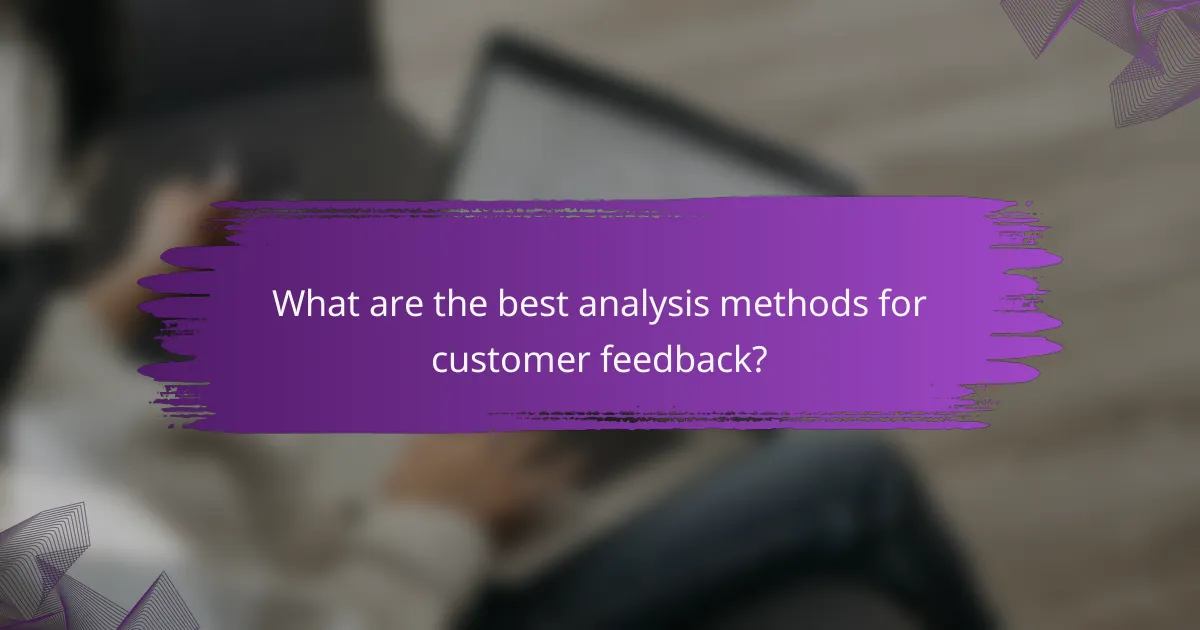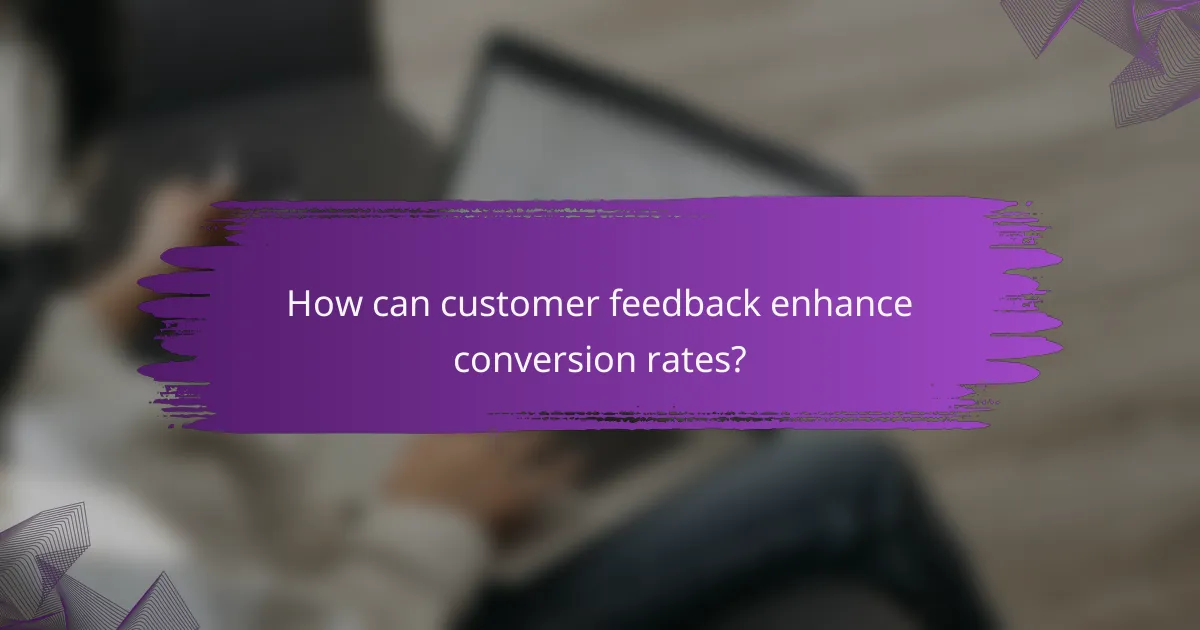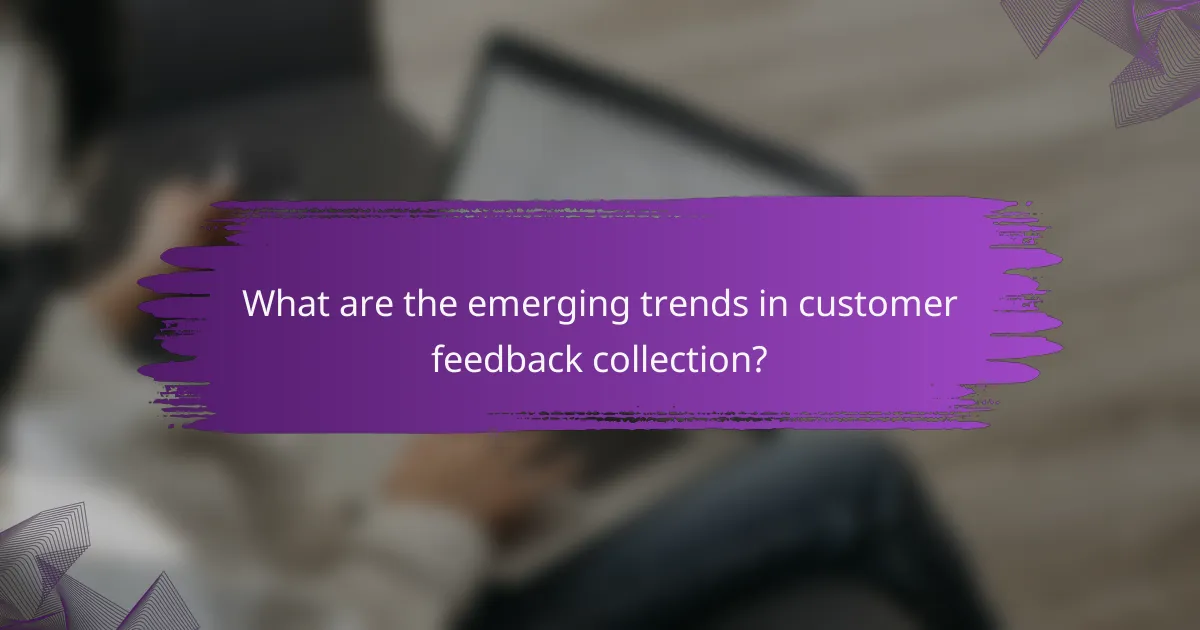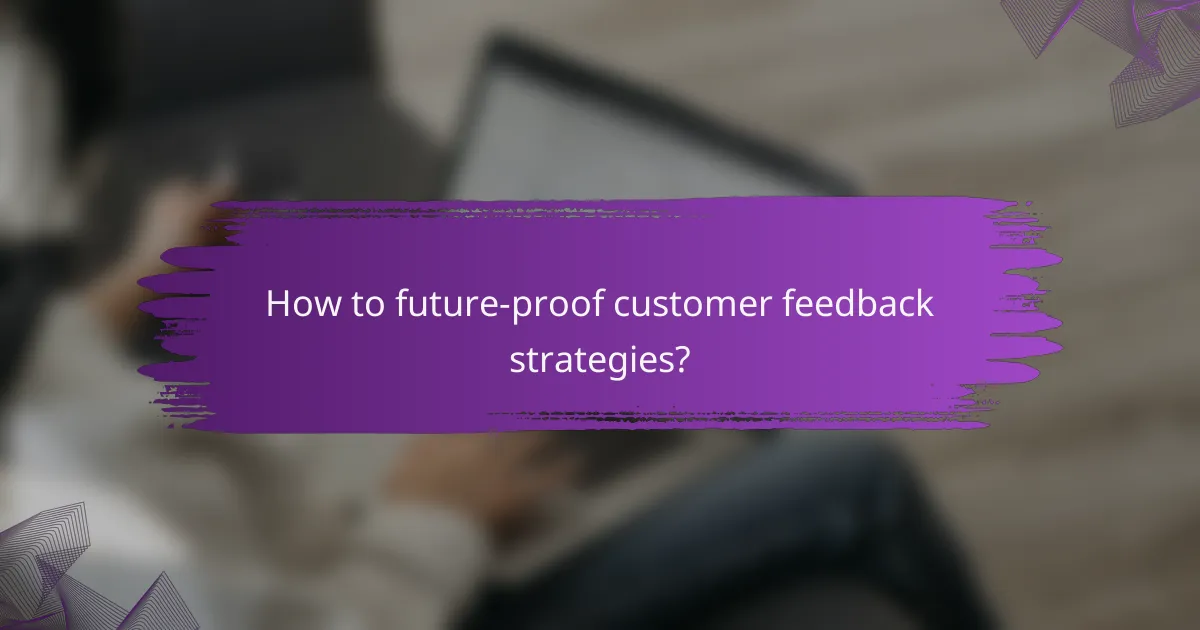Collecting customer feedback effectively is essential for informing business decisions and enhancing user experiences. By employing various methods tailored to your audience and goals, you can gain valuable insights into customer preferences and pain points. Analyzing this feedback through techniques like sentiment analysis and data visualization can lead to significant improvements in conversion rates and overall customer satisfaction.

How to collect customer feedback effectively?
Collecting customer feedback effectively involves utilizing various methods to gather insights that can inform business decisions. The right approach depends on your target audience, resources, and specific goals.
Online surveys using SurveyMonkey
Online surveys, particularly through platforms like SurveyMonkey, allow businesses to reach a broad audience quickly. These surveys can be customized with various question types, including multiple-choice and open-ended questions, making it easy to gather detailed feedback.
To maximize response rates, keep surveys concise, ideally under 10 questions, and offer incentives such as discounts or entry into a prize draw. Aim for a completion time of under five minutes to maintain engagement.
In-person interviews
In-person interviews provide an opportunity for deeper insights through direct interaction with customers. This method allows for follow-up questions and clarifications, leading to richer qualitative data.
When conducting interviews, choose a comfortable setting and prepare a set of open-ended questions. Aim for a duration of 30 to 60 minutes to ensure thorough discussions without overwhelming participants.
Social media polls on Facebook
Social media polls, especially on platforms like Facebook, are a quick way to gauge customer opinions and preferences. These polls can be created easily and shared with your audience, encouraging engagement and interaction.
Keep polls simple, focusing on one question at a time, and consider using visuals to attract attention. Monitor responses in real-time to adapt your marketing strategies based on feedback.
Email feedback requests
Email feedback requests can effectively reach customers who have recently interacted with your business. Sending a follow-up email asking for their thoughts can yield valuable insights into their experience.
Personalize emails to increase response rates and include a clear call-to-action. Offering a small incentive, such as a discount code, can also encourage participation.
Focus groups with local customers
Focus groups bring together a small group of local customers to discuss their experiences and opinions about your products or services. This method fosters discussion and can reveal insights that individual surveys may miss.
When organizing focus groups, select a diverse group of participants and prepare guiding questions to facilitate conversation. Sessions should last about 1 to 2 hours, allowing ample time for discussion while keeping participants engaged.

What are the best analysis methods for customer feedback?
The best analysis methods for customer feedback include sentiment analysis, data visualization, and text analysis. Each method offers unique insights and can significantly enhance understanding of customer opinions and experiences.
Sentiment analysis with Google Cloud Natural Language
Sentiment analysis using Google Cloud Natural Language helps businesses gauge customer emotions expressed in feedback. This tool analyzes text to determine whether the sentiment is positive, negative, or neutral, providing a quick overview of customer feelings.
To implement this, businesses can input customer reviews or survey responses into the platform. It processes the data and returns sentiment scores, which can guide decision-making. However, consider that context can affect sentiment interpretation, so review results carefully.
Data visualization using Tableau
Data visualization with Tableau transforms complex customer feedback data into interactive and understandable visuals. This method allows businesses to identify trends and patterns in customer opinions through graphs, charts, and dashboards.
When using Tableau, start by importing your feedback data and selecting the right visualization type for your analysis goals. Regularly update your dashboards to reflect new data, and ensure that visuals are clear and easy to interpret to facilitate informed decisions.
Text analysis with NVivo
Text analysis with NVivo enables a deep dive into qualitative customer feedback by categorizing and coding responses. This method helps identify recurring themes and insights that may not be immediately apparent through quantitative analysis.
To effectively use NVivo, begin by importing your text data and creating codes based on common themes. Regularly review and refine these codes to ensure they accurately represent the data. This approach can uncover valuable insights that drive product improvements and customer satisfaction initiatives.

How can customer feedback enhance conversion rates?
Customer feedback can significantly enhance conversion rates by providing insights into customer preferences and pain points. By understanding what customers value or dislike, businesses can make informed adjustments that lead to improved user experiences and increased sales.
Implementing changes based on feedback
Implementing changes based on customer feedback involves actively listening to what customers are saying and making necessary adjustments to products or services. This could mean refining features, improving customer service, or addressing common complaints. For example, if multiple customers mention a confusing checkout process, simplifying it could lead to higher conversion rates.
Regularly reviewing feedback and prioritizing changes based on frequency and impact can help businesses focus their efforts effectively. Consider using a feedback management system to track suggestions and monitor the results of implemented changes over time.
Using testimonials on landing pages
Incorporating testimonials on landing pages can build trust and credibility, which are essential for enhancing conversion rates. Positive reviews from satisfied customers can reassure potential buyers about the quality of a product or service. Aim to showcase a variety of testimonials that highlight different aspects of your offerings.
To maximize impact, place testimonials prominently on the page, ideally near calls to action. Including photos or names can also enhance authenticity, making potential customers more likely to convert.
Personalizing customer experiences
Personalizing customer experiences based on feedback can significantly boost conversion rates by making customers feel valued and understood. This can be achieved through targeted marketing, tailored product recommendations, or customized user interfaces. For instance, using data from past purchases to suggest relevant products can enhance the shopping experience.
Consider segmenting your audience based on feedback and behavior to deliver more relevant content. Tools like email marketing automation can help in sending personalized messages that resonate with specific customer groups, increasing the likelihood of conversion.

What frameworks exist for evaluating feedback collection methods?
Evaluating feedback collection methods involves frameworks that assess their effectiveness, efficiency, and impact on decision-making. Key considerations include the type of data collected, the tools used, and the overall goals of the feedback process.
Qualitative vs. quantitative analysis
Qualitative analysis focuses on understanding the underlying reasons and motivations behind customer feedback, often through open-ended questions and interviews. This method provides rich insights but can be time-consuming and subjective.
In contrast, quantitative analysis uses structured surveys and metrics to gather numerical data, allowing for statistical analysis and easier comparison. While it offers clear, measurable results, it may overlook deeper insights that qualitative methods can reveal.
Cost-benefit analysis of feedback tools
Conducting a cost-benefit analysis of feedback tools involves comparing the expenses associated with each tool against the benefits they provide. Consider factors such as subscription fees, implementation costs, and the potential increase in customer satisfaction or retention.
For example, a tool that costs around $50 per month might seem expensive, but if it leads to a 10% increase in customer retention, the long-term financial benefits could outweigh the costs. Always evaluate tools based on your specific needs and budget constraints.

What are the emerging trends in customer feedback collection?
Emerging trends in customer feedback collection focus on leveraging technology to enhance the speed and accuracy of data gathering. Key methods include AI-driven analysis, real-time feedback via chatbots, and seamless integration with CRM systems.
AI-driven feedback analysis
AI-driven feedback analysis utilizes machine learning algorithms to process large volumes of customer responses quickly. This technology can identify patterns and sentiments, providing businesses with actionable insights without the need for extensive manual review.
Companies can implement AI tools to categorize feedback into themes, helping prioritize areas for improvement. For instance, a retail brand might discover through AI analysis that customer complaints about delivery times are rising, prompting immediate action.
Real-time feedback collection via chatbots
Real-time feedback collection through chatbots allows businesses to gather customer opinions instantly during interactions. Chatbots can prompt users for feedback immediately after a purchase or service experience, capturing insights while the experience is fresh.
Implementing chatbots can increase response rates significantly, as they provide a convenient way for customers to share their thoughts. Businesses should ensure that chatbot interactions are user-friendly and that follow-up questions are relevant to enhance the quality of feedback received.
Integration of feedback with CRM systems
Integrating customer feedback with CRM systems creates a holistic view of customer interactions and preferences. This integration allows businesses to track feedback trends over time and correlate them with customer behavior and sales data.
To effectively leverage this integration, companies should ensure that feedback data is easily accessible within their CRM. This can facilitate targeted marketing campaigns and personalized customer service, ultimately enhancing customer satisfaction and loyalty.

How to future-proof customer feedback strategies?
To future-proof customer feedback strategies, businesses should embrace flexibility and adaptability in their methods. This involves integrating various channels for feedback collection, analyzing data effectively, and continuously refining approaches based on evolving customer needs.
Adopting omnichannel feedback approaches
Adopting omnichannel feedback approaches means utilizing multiple channels to gather customer insights, such as surveys, social media, email, and live chat. This strategy ensures that feedback is collected from diverse customer segments, enhancing the overall understanding of customer sentiment.
Consider implementing a mix of digital and traditional methods. For example, online surveys can be complemented with in-store feedback kiosks to capture insights from both online and offline customers. This approach can lead to a more comprehensive view of customer experiences.
When adopting omnichannel strategies, prioritize seamless integration of feedback channels. Ensure that data from different sources is consolidated for analysis, allowing for a unified view of customer opinions. Regularly review and adjust your channels based on customer preferences and emerging trends to stay relevant.


